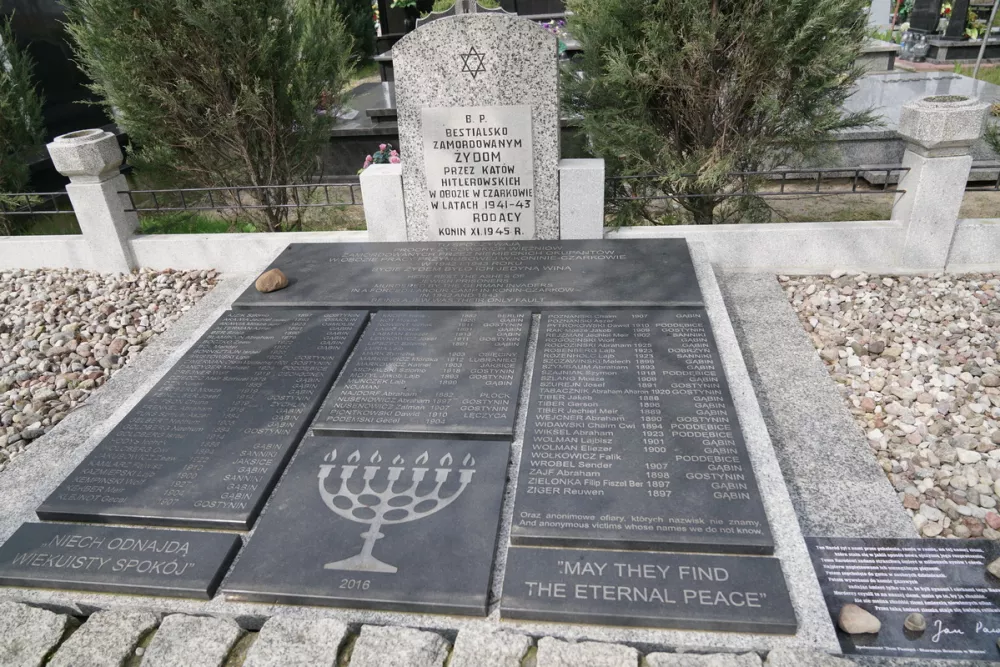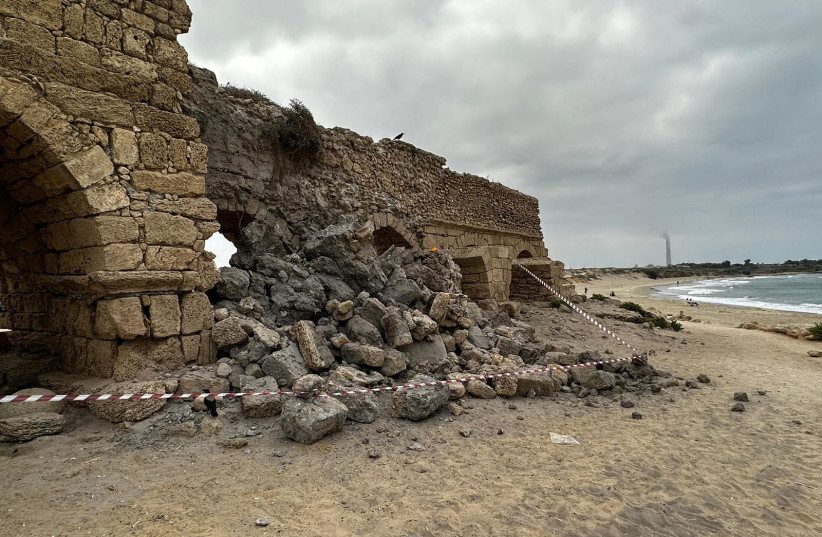
 „Chcemy zrobić to, co Samson”… Bunt więźniów obozu pracy przymusowej w Koninie-Czarkowie (12 sierpnia 1943 r.)
„Chcemy zrobić to, co Samson”… Bunt więźniów obozu pracy przymusowej w Koninie-Czarkowie (12 sierpnia 1943 r.)
Szymon Pietrzykowski

Masowa mogiła ofiar obozu pracy w Koninie-Czarkowie, cmentarz na ul. Kolskiej w Koninie
Gemeinschaftslager der DAF [Deustcher Arbeitsfront] Nr 23 Konin (Obóz Zbiorczy Niemieckiego Frontu Pracy nr 23 Konin) był jednym z co najmniej dwunastu obozów, w ramach których prowadzono prace związane z budową i modernizacją szlaków kolejowych wzdłuż linii Berlin–Poznań–Warszawa–Moskwa[1]. Pierwotnie podlegał Niemieckiej Kolei Rzeszy (Deutsche Reichsbahn), a od maja 1942 r., decyzją pełnomocnika Rzeszy ds. pracy Fritza Sauckela, wszystkie obozy pracy przymusowej różnego typu przeszły pod kontrolę DAF-u[2]. Przez kilkanaście miesięcy przebywało w nim łącznie około tysiąca więźniów, jednak liczebność obozu systematycznie spadała. Przy budowie torów, stacji kolejowej i parowozowni przymusowo zatrudnieni byli Żydzi sprowadzeni z gett w Gąbinie, Gostyninie, Jaksicach, Poddębicach czy Sannikach[3].
Obóz składał się z siedmiu baraków ogrodzonych drutem kolczastym – w pięciu przebywali więźniowie, dwa pozostałe przeznaczono na kuchnię i siedzibę komendanta oraz magazyn i pomieszczenia niemieckiej policji. Straż obozowa na początku składała się z około 5-6 osób, później się rozrosła. Strażnicy w przeważającej większości wywodzili się z polskich volksdeutschów. W obozie występowali więźniowie funkcyjni wyłonieni spośród Żydów – pełnili rolę pośredników między Niemcami a pozostałymi współwięźniami. Źródła mówią o różnych postawach – od serwilizmu do bohaterstwa[4].
![[2].jpg [335.59 KB]](https://www.jhi.pl/storage/image/core_files/2023/8/11/95e0fd4363dc9211fb15c8a3b6139992/jpg/jhi/preview/[2].jpg)
sporządzony na podstawie relacji polskich świadków, po 1969 r.
Śmiertelność w obozie była bardzo wysoka. Więźniowie cierpieli i umierali z powodu głodu, szerzyły się choroby (np. tyfus), na stanowiskach pracy zdarzały się częste kontuzje i wypadki, Żydzi byli też ofiarami arbitralnej przemocy ze strony załogi obozowej (żaden z jej członków nie został ukarany po wojnie – śledztwo toczone we Frankfurcie przeciwko jednemu z komendantów, Wilhelmowi Schäferowi, zostało umorzone w 1985 r. z powodu śmierci oskarżonego[5]). Ciała zmarłych z wycieńczenia bądź zabitych chowano w masowym grobie na cmentarzu katolickim przy ul. Kolskiej. Między kwietniem a wrześniem 1942 r. około 140 więźniów niedających się do dalszej pracy Niemcy wywieźli do Chełmna nad Nerem, a około 130 przeniesiono z Konina-Czarkowa do obozu pracy w Andrzejowie koło Łodzi (wykonywali tam podobne prace).
![[3].jpg [44.51 KB]](https://www.jhi.pl/storage/image/core_files/2023/8/11/6089088645d74e7037ff115454df57e0/jpg/jhi/preview/[3].jpg)
Na początku sierpnia 1943 r. ostatni więźniowie (grupa około 50-60 osób) dowiedzieli się o zbliżającej się likwidacji obozu od zaufanych członków załogi obozowej, którzy potajemnie przemycali im różne informacje ze świata zewnętrznego (m.in. o wybuchu powstania w getcie warszawskim). Jak wspomina jeden z ocalałych, Zygmunt Pytel (1904–1996): „Mówił nam o tym w tajemnicy magazynier Niemiec (nazwiska nie znam), który ostrzegł nas, że z chwilą likwidacji obozu wszyscy więźniowie zostaną zlikwidowani także. Nie znając możliwości ratunku postanowiliśmy w tajemnicy podpalić cały obóz, a w płomieniach popełnić wszyscy samobójstwo przez powieszenie się. Dnia tego nie ustaliliśmy jednak dokładnie, czekając na dalszy rozwój wypadków”[6].
12 sierpnia 1943 r. w godzinach popołudniowych cześć więźniów (głównie pozostający tamtego dnia na miejscu więźniowie funkcyjni) wznieciła pożar kilku obozowych barakach. Samobójstwo popełniło (co najmniej) dziewięć osób: Fajwisz Kamlarz, Hans Knopf (lekarz obozowy), Abraham Tabacznik, Geceł Klejnot, Abraham Najdorf, Salomon Nusynowicz, Szlama Michalski, Abraham Zajf i Fiszel Zielonka. Nazwiska te widnieją w dokumencie podpisanym przez komendanta Schäfera 9 października 1943 r.[7]. Jeden z buntowników, Fajwisz Kamlarz, przetransportowany do Konina z getta w Gąbinie 8 marca 1942 r., pozostawił po sobie testament zawierający m.in. następujące dramatyczne słowa: „Nie powinniście postrzegać tego jako wyniku naszej lekkomyślności lub tchórzostwa. Nie jesteśmy tacy. Dość już się napatrzyliśmy i nie mamy dla kogo żyć. […] Ja i kilku moich towarzyszy chcemy zrobić to, co Samson, jeśli tylko nam się powiedzie i będzie ku temu okazja. […]”[8]. Wywołane pożarem zamieszanie wykorzystała dwójka zbiegów: Chaim Strykowski i Majlich Szatan (nazwiska te podał Schäfer w późniejszym telefonogramie do nadburmistrza Łodzi i Zarządu łódzkiego getta z 24 października[9]).
![[6].jpg [119.98 KB]](https://www.jhi.pl/storage/image/core_files/2023/8/11/9f08b10b1f716eb01231bd9f14480791/jpg/jhi/preview/[6].jpg)
pozostawionych rabinowi Aaronsowi na przechowanie
przez dwóch uczestników buntu,
którzy ponieśli śmierć w jego trakcie,
Fajwisza Kamlarza i Abrahama Zajfa
Niemcy dość szybko opanowali sytuację przy pomocy funkcjonariuszy konińskiego gestapo i straży pożarnej. Resztę więźniów deportowano pod koniec miesiąca do podobozów Auschwitz-Birkenau. Zagładę przeżyło niewielu więźniów Konina-Czarkowa, po wojnie relację o swoich doświadczeniach w obozie złożyli tylko niektórzy. Jednym z nich był przywoływany już Zygmunt Pytel. Do obozu pracy trafił mniej więcej w połowie października 1942 r. z gąbińskiego getta wraz z trzema braćmi – Fajwlem, Maerem-Szymchą i Mordechajem (Mordką), z których żaden nie przeżył. W zeznaniu złożonym przed Okręgową Komisją Badania Zbrodni Hitlerowskich w Łodzi 18 listopada 1983 r. następująco przedstawił okoliczności buntu:
Któregoś dnia ja pracowałem poza obozem w pomieszczeniu jednego z niemieckich inżynierów nadzorujących pracę przy budowie torów, gdzie sprzątałem jego mieszkanie. Pracowało wtedy poza obozem więcej więźniów. Tam to przyszło do mnie dwóch nieznanych mi więźniów i powiedzieli mi, że już nadszedł czas i trzeba podpalić obóz a następnie skończyć ze sobą. Kiedy to usłyszałem tak się tym przejąłem, że padłem zemdlony i nie wiem co działo się dalej. Odzyskałem dopiero przytomność, gdy jakaś Niemka krzyczała głośno, że pali się cały obóz i dzieją się straszne rzeczy. Istotnie, kiedy oprzytomniałem, obóz cały stał w płomieniach a wokół nadjeżdżało pełno Niemców oraz oddziały straży pożarnej. Pożar ugaszono, ale wielu więźniów spłonęło w nim, popełniając uprzednio samobójstwo. Ile łącznie zginęło w taki sposób, nie umiem podać, ale ocalało nas tylko 49 i wszystkich nas następnie wywieziono do obozu koncentracyjnego w Oświęcimiu.
Kiedy mnie doprowadzono na teren płonącego jeszcze obozu widziałem spalone i płonące jeszcze ciała. Widziałem też, jak jeden z więźniów o nazwisku Hansen żył jeszcze i został na moich oczach zastrzelony przez jakiegoś przybyłego z zewnątrz funkcjonariusza policji hitlerowskiej. Tenże Hansen był z Berlina, podobno był Niemcem i nawet poprzednio służył w armii niemieckiej, ale władze dopatrzyły się, iż jest Żydem i osadziły go w tym obozie. Był on lekarzem i aby popełnić samobójstwo połknął dawkę trucizny, która była chyba zbyt mało skuteczna, bo jeszcze żył i wtedy przy mnie został jeszcze zastrzelony [najprawdopodobniej mowa o lekarzu Hansie Knopfie, zeznający omyłkowo ustalił ponadto termin buntu na późną jesień 1943 r – Sz. P.][10]
W załączonej do relacji urzędowej notatce napisano: „Rozmówca w ogóle bardzo niechętnie wspomina te czasy i podczas opowiadania płacze na wspomnienia o swym pobycie w tymże obozie w Koninie” (za: Ibidem, k. 89). Po wyzwoleniu Zygmunt Pytel był pracownikiem domu kultury w Gostyninie i rodzinnych Sannikach, kierował licznymi zespołami muzycznymi[11].
![[7].jpg [92.68 KB]](https://www.jhi.pl/storage/image/core_files/2023/8/11/8d4b9cb536e2d116e2d10a86eafdfc38/jpg/jhi/preview/[7].jpg) Zygmunt Pytel, ocalały więzień obozu pracy w Koninie-Czarkowie,
Zygmunt Pytel, ocalały więzień obozu pracy w Koninie-Czarkowie,Dzięki staraniom konińskich społeczników i samorządowców w 2003 r. na miejscu byłego obozu, w pobliżu dworca PKP, ustawiono głaz z tablicą pamiątkową. Widnieje na niej inskrypcja następującej treści: „W okresie okupacji niemieckiej w latach 1942–1943 mieścił się tutaj obóz pracy przymusowej dla Żydów, Po bucie więźniów w sierpniu 1943 r. hitlerowscy wywieźli ich do innych obozów”[12]. ![[11].jpg [519.91 KB]](https://www.jhi.pl/storage/image/core_files/2023/8/11/45cfb65fad3768a1b8b77f3b38dd6ffb/jpg/jhi/preview/[11].jpg)
Przypisy:
[1] Por. A. Ziółkowska, Obozy pracy przymusowej dla Żydów w Wielkopolsce w latach okupacji hitlerowskiej (1941-1943), Poznań 2005, s. 40-43.
[2] Por. Ibidem, s. 96; Ł. Pawlicka-Nowak, Obóz pracy dla Żydów w Koninie-Czarkowie [w:] Zwój domu niewoli. Dziennik rabina Aaronsona, więźnia niemieckiego obozu dla Żydów w Koninie-Czarkowie, 1942-1943, oprac. Ł. Pawlicka-Nowak, tłum. M. Lipska, Konin 2016, s. 21-47; J. Gulczyński, Obóz pracy dla Żydów w konińskim Czarkowie (1942-1943), Kronika Wielkopolski, 2007, nr 4, s. 31-42; T. Richmond, Uporczywe echo. Sztetl Konin – poszukiwanie, tłum. P. Szymczak, Poznań 2001, s. 351-355.
[3] Konin już od dłuższego czasu stał się Judenrein (wolny od Żydów) – pod koniec listopada ok. 1000 konińskich Żydów zostało deportowanych do Ostrowca Świętokrzyskiego. Do lata 1940 r. Żydzi z powiatu konińskiego trafili do gett w Zagórowie, Grodźcu i Rzgowie, a jesienią 1941 r. zostali zamordowani w lasach Niesłusz-Rudzica i w okolicach Kazimierza Biskupiego. Por. D. Dąbrowska, Zagłada skupisk Żydowskich w „Kraju Warty” w okresie okupacji hitlerowskiej, Biuletyn Żydowskiego Instytutu Historycznego, 13-14 (1955), s. 132-133, 135, 170-171 (Tabela 13: Rejencja Inowrocław, Powiat Konin)
[4] Ł. Pawlicka-Nowak, Obóz pracy dla Żydów w Koninie-Czarkowie, op. cit., s. 38-42.
[5] Por. Ibidem, s. 25-27; Archiwum Instytutu Pamięci Narodowej, Oddział w Poznaniu (dalej AIPN Po), Akta Główne Prokuratora w sprawie zbrodni popełnionych przez funkcjonariuszy III Rzeszy wobec osób narodowości żydowskiej osadzonych w obozie w Czarkowie koło Konina, Pismo prokuratury przy sądzie Landgericht, Frakfurt am Main, do Głównej Komisji Badania Zbrodni Hitlerowskich w Polsce z 20.12.1985 sygn. S.51/09/Zn (dawna sygnatura: OKP, III Ds. 99/67), k. 127.
[6] AIPN Po, Akta Główne Prokuratora w sprawie zbrodni popełnionych przez funkcjonariuszy III Rzeszy wobec osób narodowości żydowskiej osadzonych w obozie w Czarkowie koło Konina, Protokół z przesłuchania świadka (Zygmunt Pytel, Łódź, 18.11.1973), sygn. S.51/09/Zn, (dawna sygnatura: OKP, III Ds. 99/67), k. 87.
[7] Por. Ł. Pawlicka-Nowak, Obóz pracy dla Żydów w Koninie-Czarkowie, op. cit., s. 24.
[8] Za: A. Styczyńska, „Nie powinniście postrzegać tego jako wyniku naszej lekkomyślności lub tchórzostwa”. Testamenty Fajwisza Kamlarza i Abrahama Zajfa, uczestników buntu w obozie pracy przymusowej dla Żydów w Koninie, Zagłada Żydów. Studia i Materiały, R. 2022, nr. 18, s. 569.
[9] Ibidem, s. 24.
[10] AIPN Po, Akta Główne Prokuratora w sprawie zbrodni popełnionych przez funkcjonariuszy III Rzeszy wobec osób narodowości żydowskiej osadzonych w obozie w Czarkowie koło Konina, Protokół z przesłuchania świadka (Zygmunt Pytel, Łódź, 18.11.1973), sygn. S.51/09/Zn, (dawna sygnatura: OKP, III Ds. 99/67), k. 87-88.
[11] Ibidem, s. k. 89. Por. B. Konarska-Pabiniak, Pytel Zygmunt (Salomon) (1904-1996) – ocalały z Holokaustu, skrzypek, kierownik zespołów muzycznych [w:] Gostyniński słownik biograficzny, red. B. Konarska-Pabiniak, Gostynin 2017, s. 304-305.
[12] J. Gulczyński, Obóz pracy dla Żydów w konińskim Czarkowie (1942-1943), s. 41.
Zawartość publikowanych artykułów i materiałów nie reprezentuje poglądów ani opinii Reunion’68,
ani też webmastera Blogu Reunion’68, chyba ze jest to wyraźnie zaznaczone.
Twoje uwagi, linki, własne artykuły lub wiadomości prześlij na adres:
webmaster@reunion68.com


 Swastika stickers found on the Alaska Jewish Museum and “Mad Myrna’s” bar on May 26, 2021. Photo: Anchorage Police Department.
Swastika stickers found on the Alaska Jewish Museum and “Mad Myrna’s” bar on May 26, 2021. Photo: Anchorage Police Department.






